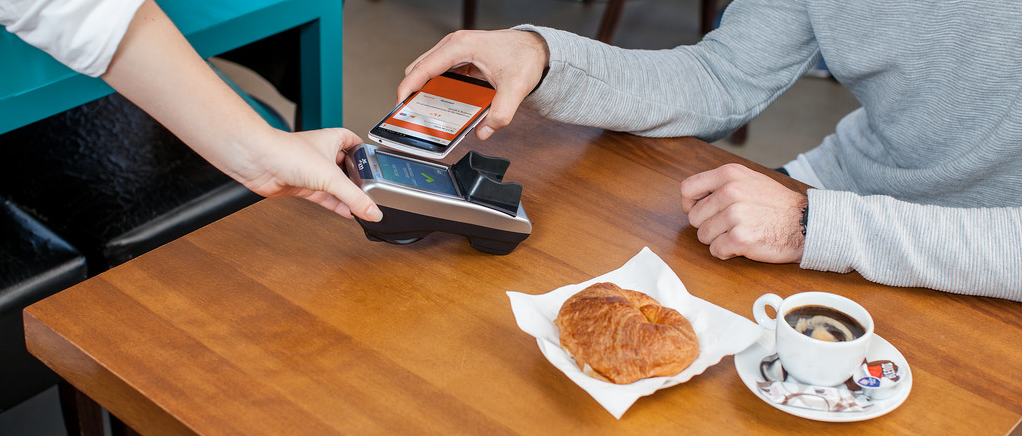Surveillance through a new way of payment
A couple of days ago I lost my debit card. At first I thought it was fine because I do not need to use it that often, but after some hours I already noticed that it is quite inconvenient not to have a debit card with you. While thinking about a solution for this problem I recalled an e-mail I received a couple of months ago from the ING bank in which they were introducing something new: contactless payment with your smartphone.
How it works
The application of the ING bank for paying without contact with a smartphone can be used for payments of a small amount of money. For payments under the amount of € 25 it is no longer necessary to punch in your pin code. Putting the smartphone against the payment machine is enough to fulfil the payment. The screen immediately shows if the payment is successful.

The underlying technique of contactless payment with a smartphone is working the same way as paying without contact with your debit card. It uses a chip that contains certain information. With a smartphone the information that is normally stored at the chip is now saved in a secured section of the smartphone (Manen). In The Netherlands it is only possible for users of an Android smartphone (NFC + Android 4.4 or higher to pay with their smartphones with the application of the ING bank, and not for iPhones users. The reason for this is that Apple is not releasing the NFC-chip for other applications than Apple Pay (Huijbregts).
The future
The use of contactless payment with a smartphone gives a small preview of what more will happen in the future. Such as the video below shows, more and more daily proceedings are being integrated in just one device; the smartphone. For example, take a look at the replacement of cameras, but also e-mailing and watching television are already taken over by the use of smartphones. It is interesting to think about what more is about to come and if it will be safe for us to arrange all of our banking online and with our smartphones.
https://www.youtube.com/watch?v=jm6wSFJVGtA
Surveillance
It also is interesting to think about contactless payment with a smartphone from the perspective of surveillance. What data is being stored? What happens with information that the application conceives? How do we know that our data is safe? Is there someone in control over this data?
Data surveillance
In the article ‘Big Data Surveillance and the Body-subject’ Kirstie Ball et al. use the idea of data surveillance in a way of companies using a big data strategy. It is about collecting data and sometimes it does not even require active use of a device by a person. Data collection by companies happens automatic and passive through sensors in cars, phones, buildings, etc. Companies collect data streams, analyse them and conclude human behaviour out of it. They generate ‘actionable insight’ (61). Ball et al. state:
“Particularly in marketing settings, the object is to leverage insight about consumers gleaned from data in order to ‘persuade’ (or manipulate) them into buying a product or using a service and to target marketing efforts more effectively” (61).
Data surveillance is about using data for a company’s profit. Another way of the use of surveillance is theorized by Philip E. Agre in his article ‘Surveillance and Capture’.
Capture model
From the perspective of surveillance the capture model of Agre can be used. The capture model is not about capturing real data and store it somewhere, but it is about the aspect of structuring activities through the use of grammars of action. Agre states about the capture model:
“What matters in each case is not the sequences of “inputs” to or “outputs” from a given machine, but rather the ways in which human activities have been structured. The capture model describes the situation that results when grammars of action are imposed upon human activities, and when the newly reorganized activities are represented by computers in real time” (746).
Grammars of action structure the activities of a user. In that way one could argue that the grammars of action of the contactless payment application of the ING bank structure the way we do our activities. It structures how we pay and maybe even if we decide to buy something, rather than not buying it because we do not have a debit card with us.
Contactless payment
When using the application for contactless payment with my smartphone I am not really aware of the aspect of surveillance in what way so ever. It might be that the ING bank uses my data for their own profits, or that it structures my activities in some way, but I am happy it makes possible a completely new way of paying which is convenient in every way, especially for those who are optimistic about the digital age.
References
- French, Martin, Smith, Gavin JD, Ball, Kirstie, Di Domenico, MariaLaura, and Nunan, Daniel. “Big Data Surveillance and the Body-subject.” Body & Society 22.2: 58-81. Web.
- Huijbregts, Julian. ING brengt Android-app voor contactloos betalen via nfc uit. Tweakers. 2015. 16 September 2016. <https://tweakers.net/nieuws/106557/ing-brengt-android-app-voor-contactloos-betalen-via-nfc-uit.html>
- Manen van, Thomas. De staat van mobile betalen in Nederland in 2016. Marketingfacts. 2016. 15 September 2016. < http://www.marketingfacts.nl/berichten/de-staat-van-mobiel-betalen-in-nederland-in-2016>
- Philip E. Agre. “Surveillance and Capture. Two models of privacy. Information Society 10(2):101-127. April-June 1994.